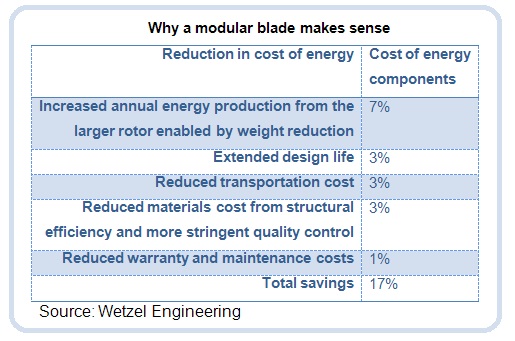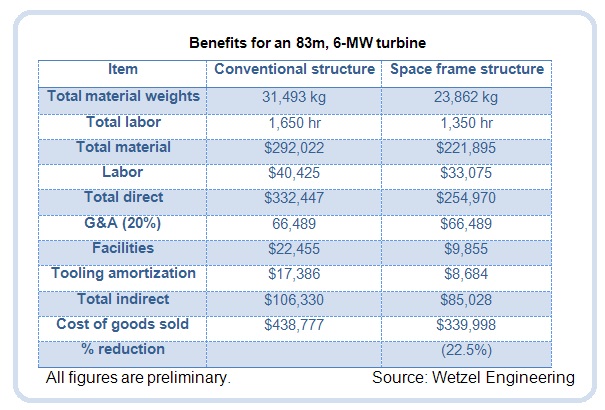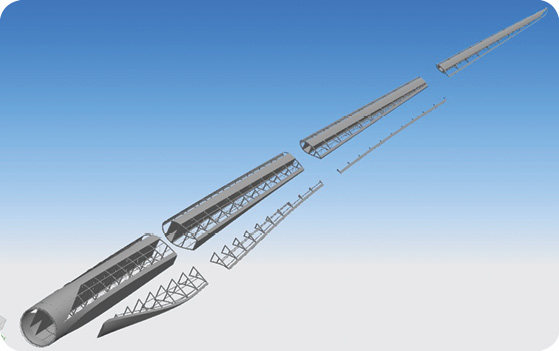A modular seven-piece blade will cost less to transport than long one-piece blades of the same length. And there are no special requirements for assembling it on site.
At the recent Sandia Wind Turbine Blade Workshop, blade design firm Wetzel Engineering, (www.wetzelengineering.com) also said the seven piece design will be less expensive to build and may result in better manufacturing quality than conventional versions.
Long conventional blades are now exposing their shortcomings. “For instance, many in the industry talk about the quality problems. But I think the industry gets admirable quality out of the wrong manufacturing process. For instance, blades are built the same way when they were 10m. Now they are 60m and more, and the current methods are inappropriate for 60 or 70m blades,” says Wetzel Engineering CEO Kyle Wetzel.
Other speakers at the Sandia workshop mentioned transporting long blades is difficult because of the costs associated with route approvals, certifications, and the necessary escorts. What’s more, after years of making blades by infusing fiberglass with resin, Wetzel says he’s no longer a big fan of the process. “It raises a lot of quality issues, such as in-plane and out-of-plane fiber misalignment, delamination, voids, and so on, so I think we are trying to infuse way too much fabric,” he says.
Wetzel’s modular blade solves most of the manufacturing and transportation problems. It uses three spars connected in series, bonded without infusion. “We have a box spar in the middle with shear webs bonded to spar caps on the top and bottom. A D-spar is on leading edge and a C-channel on trailing edge. Those pieces are connected by ribs, with tail panels lightly structured to carry aerodynamic loads and keep the shape,” says Wetzel. “Solid spars mean there is no conventional truss structure to support the main spars. We use pultruded spars and minimum infused fabric,” he adds.

To understand some of the challenges of transporting a long structure, count the lead and trailing vehicles. A modular blade such as the one proposed will avoid tight turns as well as other difficulties.
Primary motivation for the modular blade, he says, is to eliminate the core in the shell and get rid of structural skins. The four middle sections will be factory assembled and everything else assembled using fixtures so there is no blind bonding. Parts are sized for transport, but the major sections are field assembled.
Another design goal is to eliminate the huge clamshell molds. “Putting 60 and 70m clamshell molds together creates many tolerance problems. And we wanted to eliminate blind bonding because it’s difficult to control and inspect. Also, the space frame lends itself to modularization, making it easy to divide the blade into smaller parts,” says Wetzel. Space frames allow substantial reduction in weight and cost and help address buckling in a more efficient manner.
 Modularization also helps improve quality partly because everything can be inspected before it’s locked down and bonded. “This eliminates laminate-related quality problems along with weight tolerances associated with infusion of fabric and core. It is easier to inspect adhesive bonds and generally provides a more fault-tolerant design. Loads are carried on more spars and stringers. It’s also a surprise to many who assume that putting all these pieces together is labor intensive, but it’s not. In fact, it’s more amenable to automation than current fab techniques. Laying up 30 tons of dry glass and infusing it is labor intensive process,” Wetzel adds.
Modularization also helps improve quality partly because everything can be inspected before it’s locked down and bonded. “This eliminates laminate-related quality problems along with weight tolerances associated with infusion of fabric and core. It is easier to inspect adhesive bonds and generally provides a more fault-tolerant design. Loads are carried on more spars and stringers. It’s also a surprise to many who assume that putting all these pieces together is labor intensive, but it’s not. In fact, it’s more amenable to automation than current fab techniques. Laying up 30 tons of dry glass and infusing it is labor intensive process,” Wetzel adds.
Further motivation for modularization comes from transport issues. The next few years will see 5 and 6-MW turbines on land-based applications. The cost saving for putting up, for example, 5 large turbines rather than 10 smaller ones is worth it if the industry can figure how to get the hardware to the site.
 Conventional 83m blades today cannot travel over long distances in the U.S. because there are no trailers capable of handling them. “Transport companies say the longest blade that can move easily in the U.S. is about 57m. You could expand the trailers, but 83m is off the charts. The companies we spoke to estimated the cost of moving one such blade 1,000 mi. from $115,000 to $150,000. And that would add to 3 to 5% of the total installed cost for a 6-MW turbine. Multiply that by three for the whole turbine and the price climbs to about $400,000 for transportation,” he says.
Conventional 83m blades today cannot travel over long distances in the U.S. because there are no trailers capable of handling them. “Transport companies say the longest blade that can move easily in the U.S. is about 57m. You could expand the trailers, but 83m is off the charts. The companies we spoke to estimated the cost of moving one such blade 1,000 mi. from $115,000 to $150,000. And that would add to 3 to 5% of the total installed cost for a 6-MW turbine. Multiply that by three for the whole turbine and the price climbs to about $400,000 for transportation,” he says.
But costs plunge to about $24,000 for each blade when the blade is divided into pieces that are less than 90-ft long. In most states 80 or 90-ft lengths can move without extreme measures such as pilot vehicles. “And if we really modularize so all pieces fit in 40ft shipping containers, transport costs drop to $15,000,” adds Wetzel.
“The real benefit for reductions in the cost of energy don’t come just from the hardware. The huge reduction in weight lets a larger rotor sit on the platform for a smaller turbine. It’s hard to find this kind of savings anywhere else,” adds Wetzel.
Alignment fixtures can ensure tight tolerances on critical elements, so the goal is to have sections come together with high tolerances and without adjustments. “The biggest challenge is the in-field bonding of major components. We took a lot of time examining in-field fab techniques from others – the military and oil-and-gas industry – and decided that final part assembly is feasible if parts self align and not need heavy fixtures,” he says.
Wetzel’s development plan is to have structural components tested by November 2014, a 9m subscale demonstrator completed by Feb 2015, and a 28.5m subscale prototype fabricated and tested by December 2015. They hope to complete the 83m detail design by May 2016. “We will build and test components at Wetzel Engineering in Austin, Texas, so the 9m and 28.5m blades will be commercially viable,” he says. Wetzel acknowledges project support of $1.15 million from the DOE. He also says several company’s around the world working on similar ideas. WPE
Filed Under: Blades, Construction, News






Commendable engineering by Mr. Wetzel, a solution expected for years. But, still, the need for a 100-ton heavy lifter for aerial transport is not in the least diminished.
A Windpower report on this ancillary topic (heavy lifter), would be helpful. Again, historically, the Russians have the most demonstrated prowess in helicopter technology.